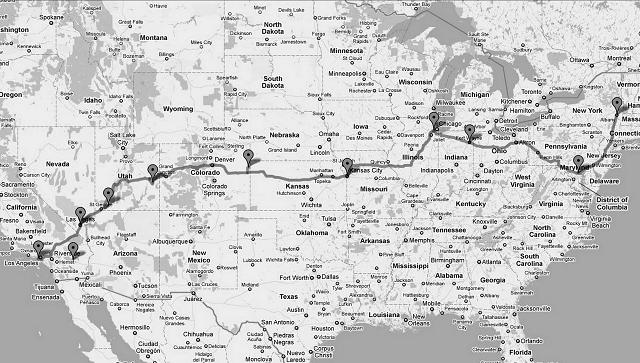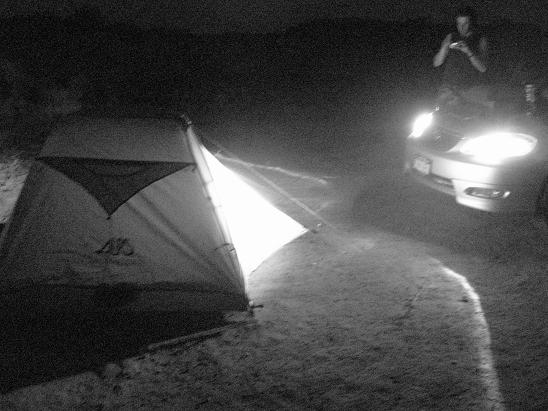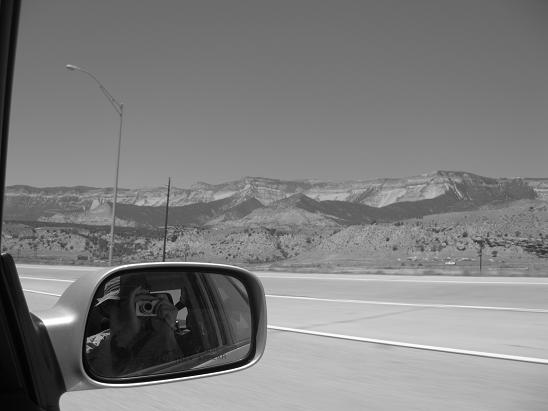Planning your move to Los Angeles can feel overwhelming. Below, I’ve tried to break down the process into digestible chunks.
Take on one piece at a time, and don’t rush or stress. Remember: This is supposed to be fun.
The Itinerary and Route
First: buy a large, updated road atlas. Combined with online mapping services like Google Maps or Bing!, you can spend a week tinkering the itinerary.
They help foresee day-to-day travel options, but an atlas makes big picture planning easier (like calculating miles and time between destinations.)
Creating a solid itinerary starts with the right questions:
- Where will you start and end your trip?
- What specific cities/towns do you want to see? Why? What’s your passion? Designing the itinerary around your passion immediately brings the trip into focus: national parks, music, breweries, sushi joints, etc.
- Who do you know along the way? Road tripping is a great opportunity to touch base with friends you haven’t seen in forever.
- How many miles or hours can you spend on the road per day? As a rough guide, calculate 50 mph on roads east of the Mississippi, and 55 mph on roads west of the Mississippi. It’s conservative and accounts for rest stops and light traffic.
- Lodging logistics. Are you crashing with friends, at hotels, or camping? If it’s the latter, how close are your destinations to campground sites?
Spend the time on research. Wrangle in concrete answers to these questions, and the itinerary takes its own shape. If you understand your own comfort levels, your route will reveal itself to you.
Trip Preparations
You’re about to take your car on a 3,000-plus mile journey: spend the time and money to ensure she’s up for it. Make sure the inspection is up-to-date, your insurance papers are intact, the tires have good treads, and the oil has been recently changed.
Do you know where your jack and spare tire are? Do you know how to change a tire? If not, learn, and learn how to do it quickly.
Check your fluids: motor, transmission, coolant, brake, steering and windshield.
Does your auto insurance provide roadside assistance? Do you have AAA membership?
Other notes to remember: check your Entertainment Book for coupons on national motels and auto body shops, notify your insurance company and credit card company you’ll be traveling, and buy a National Parks Pass for $80 if you plan on touring the parks.
Do you have the emergency contact numbers for everyone in your car in your wallet and on your phone? Do these contacts know the car’s make/model and license plate?
It’s also a good idea to keep a copy of your medical insurance card and recent photos of you and your travel mates in the car as well
Packing for the Road
Clothing
Keep three sets of clothing and a jacket accessible for the drive. If you plan on going out, include a dress shirt and shoes. Anything else pack away deep into the trunk.
What I packed:
- (7) T-shirts
- (2) Hoodies
- (2) Long-sleeves
- (6) Button-up shirts
- (6) pairs of boxers
- (4) pairs of socks
- (2) pair of jeans
- (1) pair of leggings
- (5) Ties
- (3) pairs of athletic shorts
- (2) suits
- Northface Trail Shoes
- Sandals
- Black Dress Shoes
- Puma Walking Shoes
Electronics
If you don’t feel like making three dozen CD’s, buy an mp3 player and make sure you have a tape hook-up or auxiliary hook-up to your car’s stereo.
If you don’t have one of these, consider making one yourself.
Double-check you packed your camera.
Also, cigarette lighter à outlet converter comes in handy.
Generally, a laptop is pretty useless on the road unless you’re actively trying to write. A smart phone and data plan does come in handy, however.
What I packed:
- iPod
- Laptop (w/ charger)
- Camera (w/ charger and spare battery)
- Spare Cell phone
Camping
Camping will save you money – whether it’s at National Parks, State Parks and Forests, or just pulled over on some side road in Utah. But you’ll need some things:
- A cooler – which can be a hard cooler, or a cooler bag, with a refreezeable ice pack.
- Extra plastic, zip-lock bags for leftover food and miscellaneous items.
- Buy a tent – the ALPS Mountaineering Zephyr 2 Tent 2-Person 3-Season Tent serves well and costs around $90.
- A sleeping bag.
- A sleeping mat is a nice addition to elevate yourself off cold, rock surfaces. Check out – the ALPS mountaineering lightweight pad.
- Other miscellaneous items: knife, matches, toiletries and toilet paper
Food
Spending 8 to 10 hours in a sedentary position, staring off into the void called Illinois or Kansas doesn’t burn many calories, so you’ll eat less.
If you don’t require much variety in your diet during the trip, you can really save money on food. We got away with two peanut butter and jelly sandwiches per day per person, a few bags full of nuts, some fruit, and plenty of water and coffee.
Or, you can splurge and eat out every time you stop – with food you can really spend as much or as little as you want.
What I packed:
- Peanut butter-Jelly sandwiches
- Fruit: apples, bananas, cherry tomatoes
- Mixed nuts
- Road Trip Snacks
The Car
The trip was completed in a 2006 Corolla-S sedan manual transmission. Two people were moving out to Los Angeles permanently, the third was traveling out with six weeks worth of belongings.
The fit was tight in the car, but not completely uncomfortable. Moving in one vehicle is a daunting proposition for folks who’ve been settled down for a few years, and own possessions like beds and dressers and brushed silver frames.
If you must bring these belongings, this wikiHow article explains different options – Step 11 gives an overview. None of the passengers have embarked on an extended road trip before.
Personally, before this trip, I’ve rarely popped my car’s hood, never changed a tire, and my idea of “camping” was renting a house with satellite television, dishwasher, and at least two working bathrooms.
- Jumper cables
- Spare Fluids
- Spare tire and jack
- Map – Rand McNally 2010 US Map
- LA street map
Other
- Toiletries
- Toilet Paper
- Notebook
- (2) Skateboards
Budget
If you’d like to budget and determine an approximate cost for your road trip, having a solid itinerary and seriously considering your lodging options will go a long way towards this. I’ve included our budgeted and actual costs for your reference.
The budgeted (not actual) is as follows:
Distance / Gas
- Total miles: 4,350
- 10 hours driving time/day
- Fill up every 10 gallons.
- The vehicle gets 27 miles to the gallon of gas. That’s 270 miles per fill-up; or about 16 tanks to get across the country. At $2.80 per gallon (or $28 per fill-up) it’ll cost $448 to cross the states.
Food
$20 per day, for 10 days. Plus the initial $20 for food, per person, we arrive at $220.
Lodging
We’ll visit and camp at three National Parks. Total cost of the national parks will be $20, per person. Calculated into lodging are two Holiday Inn stays, in case of an emergency, which comes out to $33 per person.
The total lodging cost is $53 per person.
Miscellaneous Emergency Funds
- Total $100 Actual Costs
- The actual total cost for the group was $597 versus budgeted of $888.
- After divvying shared costs (not total costs) each person spent just under $200.
- As an individual, each person’s costs landed somewhere around $350 – $400.
The Drive
The drive lasted 10 days. On our traveling days, an average of 8 hours was spent on road time. The 50 mph east of the Mississippi, 55 mph west of the Mississippi rule will give you an accurate measure of time on the road.
We stayed the evening in the following cities: Baltimore, Maryland; Fort Wayne, Indiana; Chicago, Illinois; Kansas City, Missouri; Bonny Lake, Colorado; Moab, Utah; St. George’s, Utah; Las Vegas, Nevada; Los Angeles, California
The states passed through included: New York, New Jersey, Delaware, Maryland, Pennsylvania, Ohio, Indiana, Illinois, Missouri, Colorado, Kansas, Utah, Arizona, Nevada, California
The distance traveled (not including miles inside the towns) was 3,358 miles.
The Route
Below are trip details: start and end locations, estimated miles and time traveled, and locations for sleeping. Two great resources to find campsites are About: Student Travel and Free Campgrounds.
Day 1 – Sunday, June 13
- Start: Albany, NY
- End: Baltimore, MD
- Miles: 330 m.
- Time: 6 hr. 30 min.
Day 2 – Monday, June 14
- Start: Baltimore, MD
- End: Fort Wayne, IN
- Miles: 563 m.
- Time: 11 hr. 15 min.
Day 3 – Tuesday, June 15
- Start: Fort Wayne, IN
- End: Chicago, IL
- Miles: 203 m.
- Time: 4 hr.
Day 4 – Wednesday, June 16
- Start: Chicago, IL
- End: Kansas City, MO
- Miles 526 m.
- Time: 10 hr. 30min.
Day 5 – Thursday, June 17
- Start: Kansas City, MO
- End: Colorado Springs, CO
- Miles 591 m.
- Time: 10 hr. 45 min.
Day 6 – Friday, June 18
- Start: Colorado Springs, CO
- End: Arches National Park (Moab, Utah)
- Miles: 7 hr. 25 min.
- Time: 406 m.
Day 7 – Saturday, June 19
- Start: Arches National Park
- End: Zion National Park (Utah)
- Miles: 355 m.
- Time: 6 hr.
Day 8 – Sunday, June 20
- Start: Zion National Park
- End: Las Vegas, NV
- Miles: 163 m.
- Time: 3 hr.
Day 10 – Monday, June 22
- Start: Las Vegas, NV
- End: Los Angeles, CA
- Miles: 170 m.
- Time: 3 hr
Miscellaneous Tips
Before leaving on the trip, agree which costs will be split between travelers. For example, if the car breaks down, who contributes towards the repairs?
Driving from Colorado into Utah, for the first dozen exits, there are zero services: no gas, no telephone, no nothing. This is a fact they fail to mention at the last exit in Colorado. Make sure you fill up on gas and water.
Armed with an atlas, you can worry considerably less about exact locations to camp out for the evening. Just open the map and shoot for a spot.
Summary
If I were to do the trip again, I’d take a more “themed” approach to traveling across the states. One of the original themes I toyed around with was “Sushi Restaurants”: that’d involve visiting every famous sushi spot along the way, as well as the best restaurants in the town I’d stay in.
Such a theme presents several obstacles. First, traveling with others makes the sushi theme a difficult prospect. Unless they explicitly love the idea, the theme probably won’t excite them much.
Second, chasing sushi restaurants across America puts you at a disadvantage if you haven’t figured out your lodging logistics.
Finally, sushi isn’t a budget meal, and a road trip built on a sushi theme is not a bootstrapped trip.
If a road trip is in the future, touring more National Parks is a definite interest.
If you visit three or four national Parks, buy the National Parks Yearly Pass for $80, and many parks are switching over to the reservations system for camping – during peak season you may need to call a month ahead.
In a group road trip, your selection of travel mates is important. It is not like putting together a corporate team, or a committee to oversee the town.
Don’t look for balance and differences that provide a wide view. For a trip of short duration, focus is more important. The similarities between travel mates are more important than the differences.
Acquire travel mates who share the same standards (or lack thereof) of comfort, dining, and interest. (For example, someone who doesn’t eat fish isn’t a good candidate for the “Sushi Restaurant” themed road trip.)
###
Photo Credit: X-ray Delta One




1 Comment
Pingback: Move to LA? Los Angeles: The Complete Guide for 2022